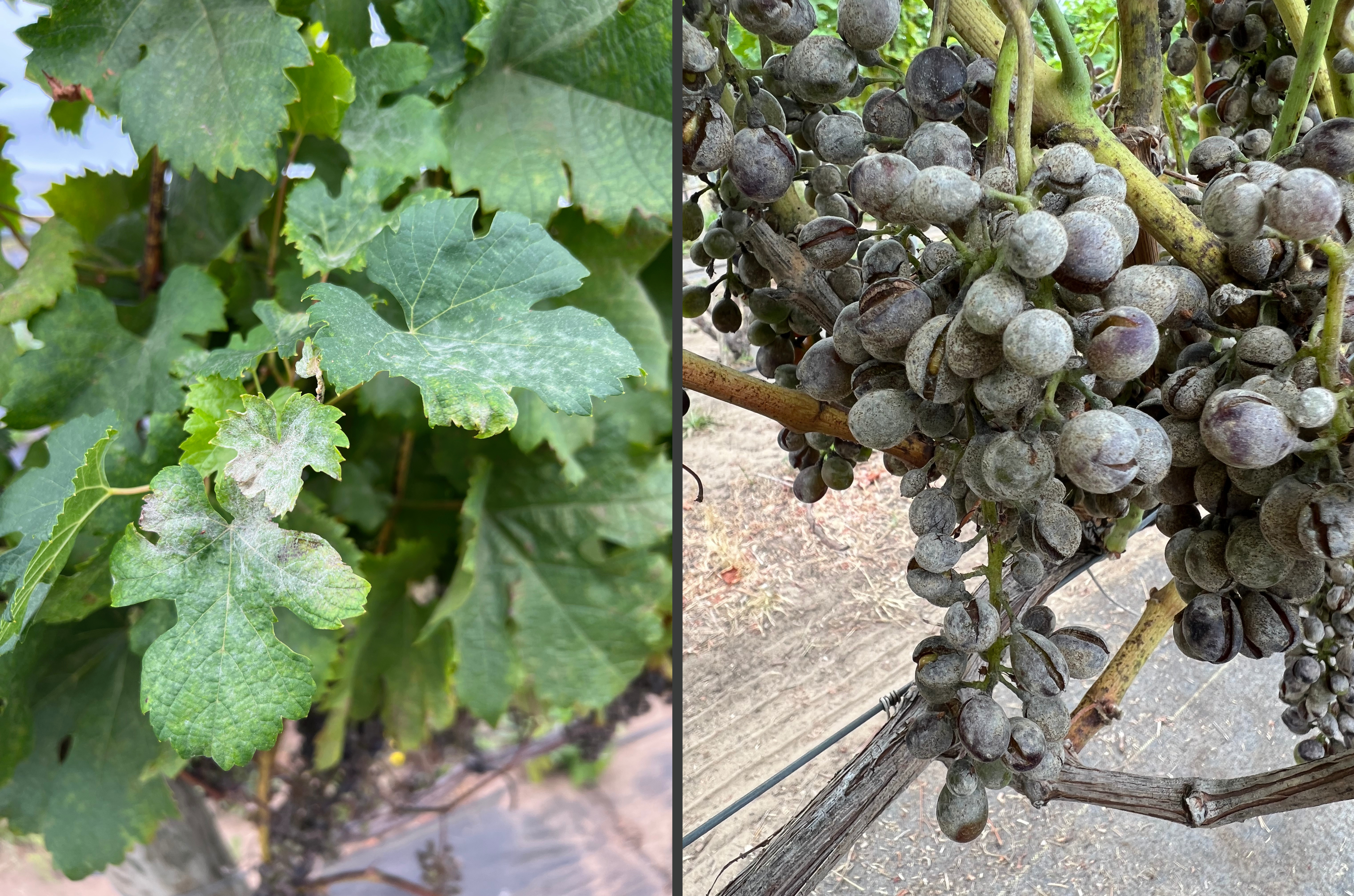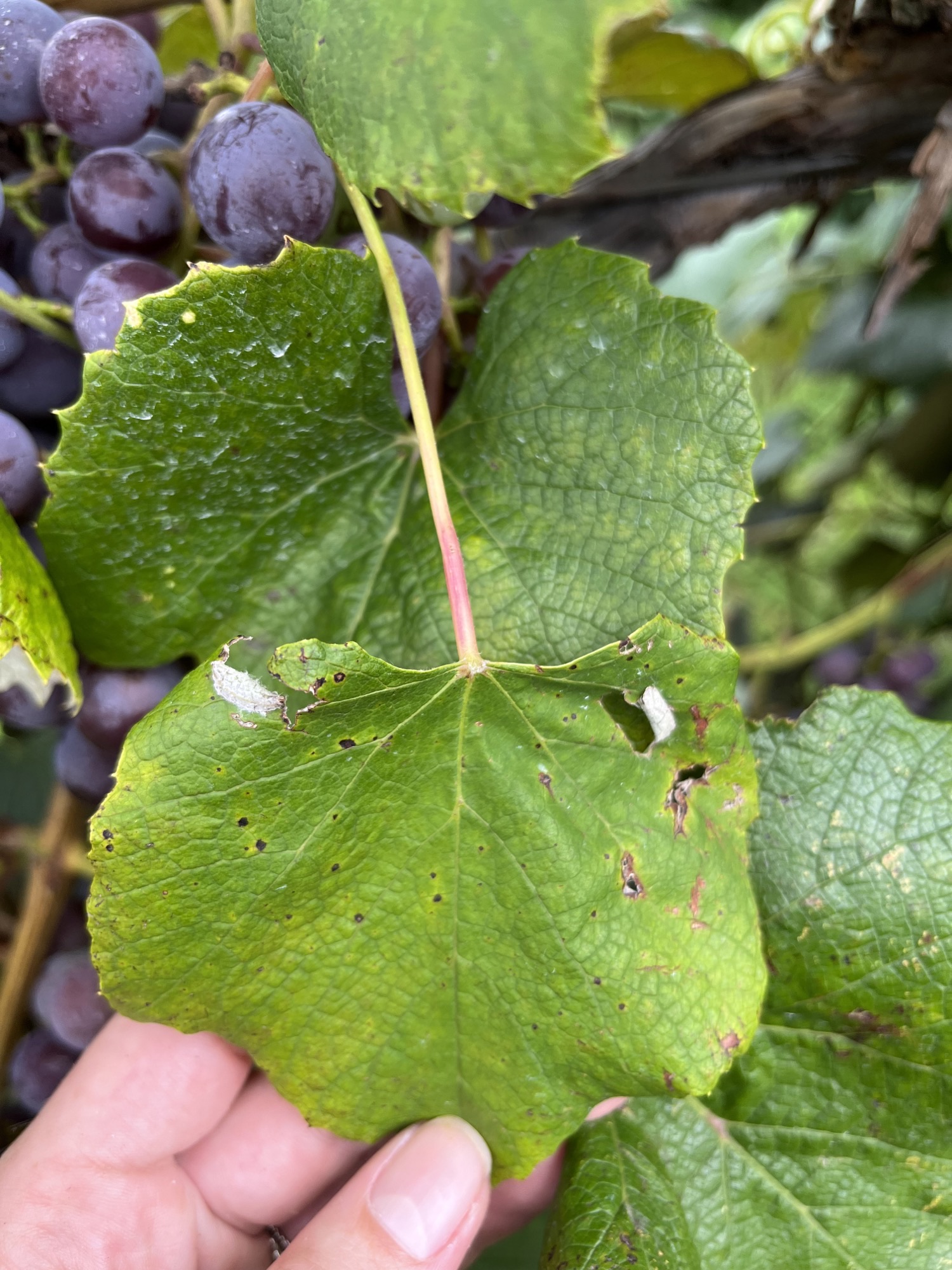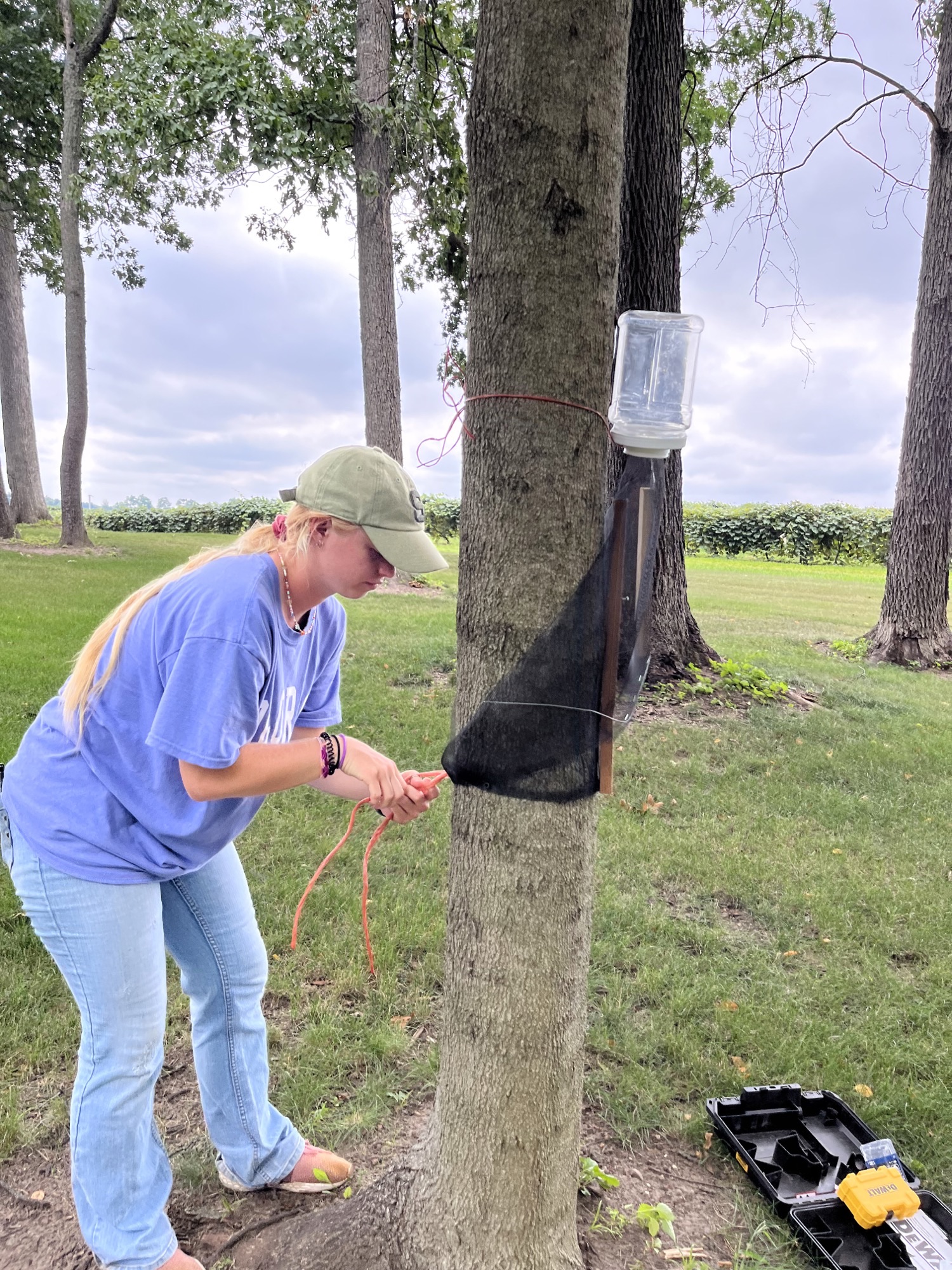Michigan grape scouting report – August 31, 2022
Time to focus on disease and bird management to protect clusters.

Weather
Click below for detailed seven-day forecasts for various grape production regions.
Southwest
Southeast
Northwest
Last week in Michigan was quite typical, with almost the same GDD accumulation as the week before. Highs in southern Michigan ranged from the mid to upper 80s, while those in northern grape regions reached the 70s and scattered rain on Thursday and Friday. Northern and central Michigan experienced the greatest rainfall.
|
Southwest Michigan GDD Summary from March 1 through Aug 24, 2022 |
|||
|
Enviroweather station |
Current GDD 50 F |
GDD 50 F last week |
Collected the past week |
|
Benton Harbor (SWMREC) |
2399 |
2245 |
154 |
|
Fennville |
2176 |
2042 |
134 |
|
Lawton |
2355 |
2217 |
138 |
|
SW Average |
2328 |
2189.5 |
138.5 |
|
Romeo |
2246 |
2103 |
143 |
|
SE Average |
2274 |
2138 |
136 |
|
Old Mission |
1845 |
1711 |
134 |
|
Petoskey |
1797 |
1664 |
133 |
|
Traverse City (NWMHRS) |
1928 |
1790 |
138 |
|
NW Average |
1817 |
1687 |
130 |
Vine growth
In southwest Michigan, harvest has begun on early wine grape varieties for sparkling wine.
Veraison is here in northern vineyards. In some locations in the Leelanau Peninsula, some early varieties such as Chardonnay show some berry softening. In the Tip of the Mitt, most cultivars are starting to see veraison.
See this chart for grape growth stages.
|
Variety |
Northwest region (Brix) |
Southwest region (Brix) |
|
Riesling |
8.1 |
-- |
|
Chardonnay |
13 |
-- |
|
Pinot noir |
11 |
-- |
|
Pinot Blanc |
13.3 |
-- |
|
Pinot Gris |
12.6 |
-- |
|
Marquette |
-- |
Not available |
|
Seyval |
-- |
Not available |
|
Aromella |
-- |
Not available |
|
Concord |
-- |
11 |
|
Niagara |
-- |
13 |
|
Chancellor |
-- |
16 |
Horticulture
As almost all of the Michigan vineyards are at veraison or just past it, this is an important time of year to control bird damage, which can be expected to begin and increase as fruit ripen. If you haven't noticed any damage yet, don't think you're safe because birds will harvest your berries a day or two before you are. The most effective kind of defense is netting. Inflatable "used car lot" balloons, propane cannons, laser bird repellents, and auditory fright calls are occasionally utilized as well, but their efficacy is debatable and their nuisance factor is high. Please check out this article for more information.
Weeds
Weed control is important at this time of the year to reduce weed interference in machine or manual harvest and to reduce the soil weed seed bank for the following season.
The application timing for most of the herbicides before harvest is mainly based on the pre-harvest interval (PHI). Aim (three-day PHI), Rely (14-day PHI) and Gramoxone (Restricted Use Pesticide) provide quick burn-down of weeds. Rely and Gramoxone control both broadleaves and grasses, but Aim is only effective for broadleaves. Venue (zero-day PHI) can be added to improve burn-down and broaden the weed control spectrum. Some herbicides will damage grape green bark, new shoots, leaves or vines, so minimize contact with vines during application.
Glyphosate also has a short 14-day PHI, but it is not advisable to apply it after bloom. Significant injury may occur during the current season or the following year if glyphosate comes in contact with leaves, green shoots or is absorbed by bark.
Detailed information related to the herbicide rates and efficacy on weeds can be obtained in the Herbicide section of E154 Michigan Fruit Management Guide, that contains lists of all currently labeled herbicides along with specific remarks for their use in vineyards.
Diseases
In the southwest, disease management of downy mildew, powdery mildew and botrytis fruit rot are the primary focus currently. In the past few weeks, we have seen significant powdery mildew pressure in southwest Michigan (Photo 2). The heavy dews we are experiencing means it is important to maintain protection against downy mildew as well. In the northwest, disease pressure is increasing and a high pressure of powdery mildew has been reported as well. Throughout Michigan, there will continue to be significant powdery mildew disease pressure due to the mild weather. These conditions can cause powdery mildew populations to increase rapidly as thousands of spores can be produced in a one day from a single infected leaf. The real danger is when powdery mildew splits the fruit and gives rise to additional fruit rots.

In this growing stage, you should consider choosing fungicides that control all the foliar and fruit diseases. For example, with downy mildew we are most concerned with foliar infection at this time and sprays should be timed regularly throughout the season when we experience heavy dews for optimal control. Downy mildew is caused by a fungal-like organism, so many site-specific systemic fungicides that target other spring diseases do not work on downy mildew. Effective fungicides for downy mildew include products in FRAC codes 4, 11, 21, 40 and 45 as well as phosphorus acid salts and some biologically-based products.
If powdery mildew is the only concern, there are a number of products that are effective (FRAC codes 3, 7, 11, 13, U8, 50, and U13 as well as sulfur). Combining fungicides from different FRAC classes should also be effective while helping with resistance management.
As we approach veraison in the southwest, it is important to consider botrytis management. Several strategies contribute to good botrytis bunch rot management including opening up the canopy, properly applying fungicides, and using resistant cultivars when possible. Good botrytis control depends on getting good coverage. Just before bunch closure is the last chance to apply a fungicide to the inner part of the developing cluster. Fungicide resistance management is also important. The most effective products for botrytis are site specific and prone to resistance development. A Michigan Grape Fact Sheet is available for managing botrytis bunch rot.
Remember as you choose a fungicide, check the guide for potential phytotoxicity of certain sprays on Concord grapes especially (this has been particularly noted for fungicides like Revus Top). Phytotoxicity risk is higher with high temperatures and quickly growing vines. Also, there is a significant phytotoxicity risk with specific contact products such as copper and sulfur for Labrusca type grapes (Concord and Niagara).
Insects
With consistent warm temperatures and an early third generation of grape berry moth, it is likely that there will be a fourth generation of grape berry moth in southern Michigan this season. The fourth generation begins at 2430 GDD from biofix (wild grape bloom). The grape berry moth model is predicting the fourth generation egg hatch will begin on Sunday, Sept. 4, in Berrien County, and sometime next week in Van Buren County (Photo 3). Many vineyards we are scouting already have a very low infestation of this pest and may not require any further control, but if there has been poor control so far this season, early September protection of the clusters should prepare growers for the harvest with vineyards with a lower risk of damage in the pre-harvest window. Always be aware of the pre-harvest intervals, and also watch out for rain showers over the coming week and avoid application just before the rain.

After the 2021 experience, we are carefully watching vineyards with weekly scouting and growers should be doing the same to make sure that cluster rots and vinegar flies do not develop to be too much of a challenge. Continue to monitor this as we approach harvest and be prepared to control rots and their vinegar fly vectors with treatments once the berries reach 14 Brix.
Scouting for spotted lanternfly has started after one detection was made in Oakland County. Traps for early detection have been placed at several vineyard sites and at rest areas along the freeway (Photo 4).

Annual Open House at the Northwest Michigan Horticultural Research Center and Bill Klein's Retirement Celebration
On Thursday, Sept. 8, 2022, the Northwest Michigan Horticultural Research Center (NWMHRC) will host its annual open house. The event this year will include a wine tasting and hors d'oeuvres during the social hour and an educational tour of the station.
Paolo Sabbatini will be present, and there will be an opportunity to discuss your vineyard management at Veraison and pre-harvest with Sabbatini from 3:00–5:00 p.m.
The evening social hour will begin at 5:00 following the vineyard educational discussion. The social hour will include wine tasting and hors d’oeuvres and will be free of charge. The NWMHRC farm manager, Mr. Bill Klein, will be retiring from Michigan State University in October 2022, so we'll take a moment during the social hour to honor him. Join us as we honor Bill's 40 years of service to the NWMRHC!
For more information, contact the NWMRHC at 231-946-1510. We hope to see many of you at this fun and educational event! The event is sponsored by Michigan State University Extension and AgBioResearch, the Leelanau Horticulture Society, P45 Vines and Wine, and the NWMHR Foundation.
Related articles
- 2022 Fruit insecticide registration update
- Southwest Michigan fruit update – June 28, 2022
- Michigan grape scouting report – June 22, 2022
- 2022 MSU Fruit Pest Management Guide (E-154)
- Grape growth stages
- A Mobile Guide for Grape IPM Scouting in North Central and Eastern U.S.
- Using the MSU Enviroweather grape berry moth model in 2018
This work is supported by the Crop Protection and Pest Management Program [grant no 2021-70006-35450] from the USDA National Institute of Food and Agriculture.



 Print
Print Email
Email